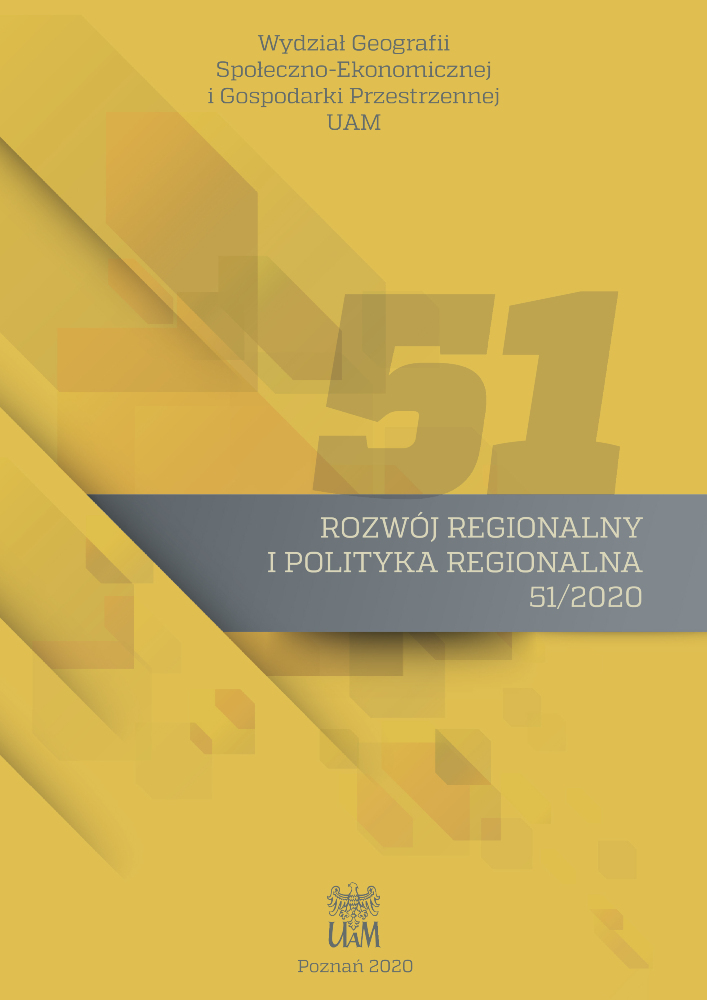Abstract
This article deals with issues related to the functioning of the neighbourhood group on Facebook during the COVID-19 pandemic. The main research method was a case study based on an analysis of the content published by the group members within 30 days after the first confirmed coronavirus COVID-19 infection was recorded in Poland. Referring to the concepts related to the typology of neighbourhood, the author presents neighbouring activities, the implementation of which was supported within the group’s activities, with particular regard to the impact of the ongoing pandemic. The article summary describes three of the functions identified in the study, which were performed by the group towards the neighbourhood community: (1) informational, (2) solidarity, (3) psychological.
Funding
projekt badawczy nr 2017/25/N/HS4/00018 finansowany ze środków Narodowego Centrum Nauki
References
Ajdukiewicz K. 1962. Logika pragmatyczna. Wydawnictwo PWN, Warszawa.
Al-Homoud M., Tassinary L.G. 2004. Social interactions at the neighborhood-level as a function of external space enclosure. Journal of Architectural and Planning Research, 21(1): 10–23 (http://www.jstor.org/stable/43031056).
Błaszczyk M. 2007. O więzi sąsiedzkiej w środowisku wielkomiejskim – na przykładzie Wrocławia. [W:] I. Borowik, K. Sztalt (red.), Współczesna socjologia miasta. Wielość oglądów i kierunków badawczych dyscypliny. Wydawnictwo Uniwersytetu Wrocławskiego, Wrocław, s. 101–119.
Bowler G.M. 2010. Netnography: A method specifically designed to study cultures and communities online. Qualitative Report, 15(5): 1270–1275.
Bujwicka A. 2011. Typy wielkomiejskiego sąsiedztwa wyobrażone a praktykowane stosunki sąsiedzkie mieszkańców Łodzi. Acta Universitatis Lodziensis. Folia Sociologica, 36: 101–119.
Burrows R., Ellison N., Woods B. 2005. Neighbourhoods on the Net: the nature and impact of Internetbased neighbourhood information systems. The Policy Press, Bristol (https://www.policy-press.org.uk/catalog/product_info.php?cPath=10129&products_id=1125).
Capece G., Costa R. 2013. The new neighbourhood in the internet era: Network communities serving local communities. Behaviour and Information Technology, 32(5): 438–448 (https://doi.org/10.1080/0144929X.2011.610825).
Cieśla S. 1979. Sąsiedztwo w mieście, pojęcie, typologia i znaczenie. Roczniki Nauk Społecznych, 7: 105–113.
Dawson C. 2020. A–Z of Digital Research Methods. London, Routledge, New York.
Drozdowski R., Frąckowiak M., Krajewski M., Kubacka M., Luczys P., Modrzyk A., Stamm A. 2020. Życie codzienne w czasach pandemii. Raport z drugiego etapu badań. Wersja pełna. Poznań.
Ellison N., Steinfield C., Lampe C. 2006. Spatially Bounded Online Social Networks and Social Capital: The Role of Facebook. Annual Conference of the International Communication Association.
Flint J. 2009. Neighborhoods and Community. [W:] R. Kitchin, N. Thrift (red.), International Encyclopedia of Human Geography. Amsterdam, Boston, Heidelberg, London, New York, Oxford, Paris, San Diego, San Francisco, Singapore, Sydney, Tokyo, s. 354–359.
Forrest R., Kearns A. 2001. Social Cohesion, Social Capital and the Neighbourhood. Urban Studies, 38(12): 2125–2143 (https://doi.org/10.1080/00420980120087081).
Hampton K.N. 2003. Grieving for a Lost Network : Collective Action in a Wired Suburb. The Information Society, 19: 417–428 (https://doi.org/10.1080/01972240390241547).
Holmgren S., Rüdiger B., Storgaard K., Tournay B. 2004. The Electronic Neighbourhood – A New Urban Space. [W:] Architecture in the Network Society. 22nd eCAADe Conference Proceedings, Copenhagen (Denmark) 15–18 September 2004. Copenhagen, s. 24–34.
Jemielniak D. 2013. Netnografia, czyli etnografia wirtualna – nowa forma badań etnograficznych. Prakseologia, 154: 97–116.
Johnson B.J., Halegoua G.R. 2014. Potential and Challenges for Social Media in the Neighborhood Context. Journal of Urban Technology, 21(4): 51–75 (https://doi.org/10.1080/10630732.2014.9 71528).
Kotus J. 2007. Natura wielkomiejskich sąsiedztw. Analiza subsąsiedzkich i sąsiedzkich terytorialnych podsystemów społecznych w Poznaniu. Wydawnictwo Naukowe UAM, Poznań.
Kotus J., Hławka B. 2010. Urban neighbourhood communities organised on-line – A new form of self-organisation in the Polish city? Cities, 27(4), 204–214 (https://doi.org/10.1016/j.cities. 2009.12.010).
Kraut R., Patterson M., Lundmark V., Kiesler S., Mukopadhyay T., Scherlis W. 1998. Internet Paradox: A Social Technology That Reduces Social Involvement and Psychological Well-Being? American Psychologist, 53(9), 1017–1031 (https://doi.org/10.1037/0003-066X.53.9.1017).
Kryczka P. 1981. Społeczność osiedla mieszkaniowego w wielkim mieście. Wydawnictwo Naukowe PWN, Warszawa.
Lengyel B., Varga A., Ságvári B., Jakobi Á., Kertész J. 2015. Geographies of an online social network. PLoS ONE, 10(9) (https://doi.org/10.1371/journal.pone.0137248).
Neves B.B. 2013. Social Capital and Internet Use: The Irrelevant, the Bad, and the Good. Sociology Compass, 7(8): 599–611 (https://doi.org/10.1111/soc4.12059).
Olson P. 1982. Urban Neighborhood Research: Its Development and Current Focus. Urban Affairs Quarterly, 17(4): 491–518 (https://doi.org/10.1177/004208168201700406).
Park R.E. 1915. The city: suggestions for the investigation of human behavior in the city environment. The American Journal of Sociology, 20(5): 577–611.
Quan-Haase A., Wellman B. 2004. How Does the Internet Affect Social Capital? [W:] M. Huysman, V. Wulf (red.), Social Capital and Information Technology. The MIT Press, Cambridge, Massachusetts, London, s. 113–132.
Sitrin M., Sembrar C. (red.) 2020. Pandemic Solidarity: Mutual Aid During the Covid-19 Crisis. Pluto Press, London.
Sosnowski A., Walkowiak J. 1983. Sąsiedztwo i jego odzwierciedlenie w świadomości mieszkańców wielkomiejskich osiedli. Studia Socjologiczne, 1: 223–244.
Sosnowski A., Walkowiak J. 1986. Życie społeczno-kulturalne osiedla w świadomości jego mieszkańców. Wydawnictwo PWN, Poznań–Warszawa.
Turkle S. 2011. Alone Together: Why We Expect More from Technology and Less from Each Other? Basic Books, New York.
Turowski J. 1976a. Kształtowanie się zbiorowości osiedlowych w wielkich miastach. Studia Socjologiczne, 60(1): 203–233.
Turowski J. 1976b. Stosunki społeczne w nowych osiedlach mieszkaniowych. Teoria i rzeczywistość. Życie i Myśl, 26(7–8): 70–93.
Unger D.G., Wandersman A. 1985. The importance of neighbors: The social, cognitive, and affective components of neighboring. American Journal of Community Psychology, 13(2): 139–169 (https://doi.org/10.1007/BF00905726).
Wellman B., Leighton B. 1979. Networks, Neighborhoods, and Communities: Approaches to the Study of the Community Question. Urban Affairs Review, 14(3): 363–390 (https://doi.org/10.1177/107808747901400305).
Winiarska A., Toruńczyk-Ruiz S. 2018. Specyfika sąsiedztwa wielkomiejskiego w Polsce. Warszawa jako przykład różnorodnego miasta? [W:] A. Górny, A. Winiarska, S. Toruńczyk-Ruiz (red.), Po sąsiedzku z różnorodnością. Interakcje w miejskich przestrzeniach lokalnych z perspektywy różnych grup mieszkańców. Wydawnictwo Naukowe SCHOLAR, Warszawa, s. 53–80.
License
Copyright (c) 2020 Tomasz Sowada

This work is licensed under a Creative Commons Attribution 4.0 International License.

